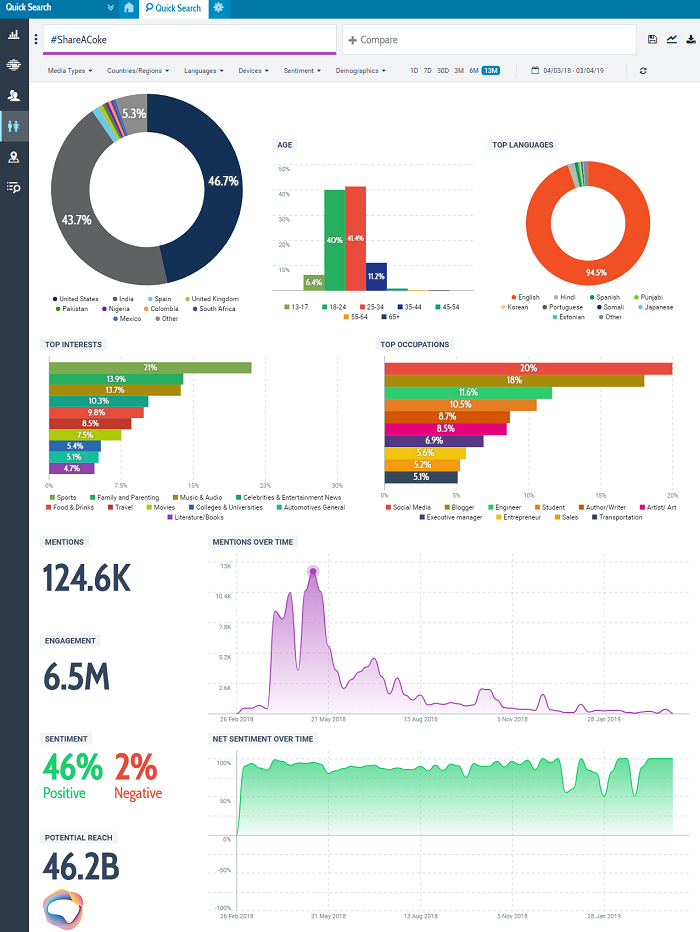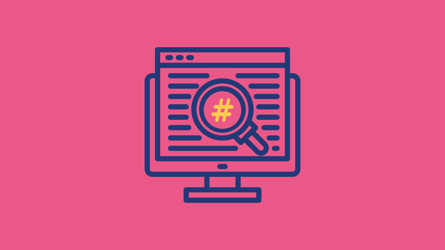I'll take my free PR Crisis eBook!
To help you deal with a PR crisis, download my PR Crisis Management eBook.
Expert advice, crisis tools and templates to help you protect your brand's reputation.
Today’s consumers are looking to trust the brands they use. They want honest messaging. Personalization. So, lose the hard-sell brand speak. Lose it now!
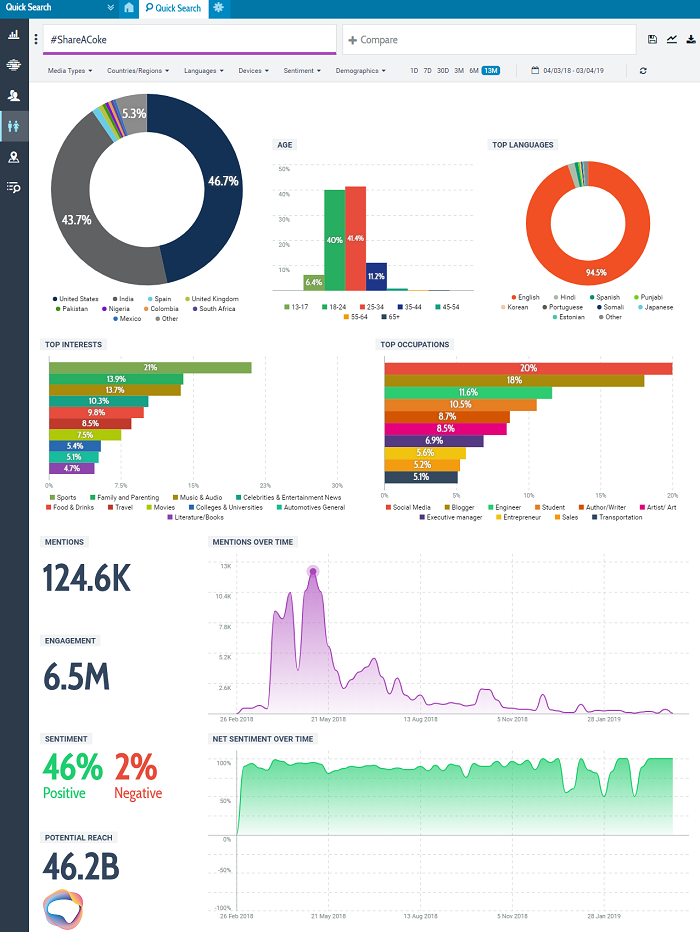
Quick Search - Coca-Cola personalization campaign.
Coca-Cola rocked personalization when it swapped it’s brand name on bottles, with 250 popular first names. The #ShareACoke campaign launched in Australia in 2011, with consumers encouraged to share a photo of their personalized bottles on social media, using the #ShareACoke hashtag.
The key to understanding what consumers want - what they really want - is collecting and analyzing consumer insights. My Consumer insights guide shows you want they will bring to your business, and where to find them. Take a look!
Table of contents
- Why your brand needs a PR strategy
- Definition of public relations
- Media - owned vs paid vs earned
- Public relations vs marketing
- What is a PR strategy?
- PR strategy tactics
- How to create a PR strategy
- PR measurement
- Free PR crisis management eBook
Why your brand needs a PR strategy
I wrote earlier that every brand needs a PR strategy. You could ignore me, but your brand will struggle to be heard in your industry and market. With a PR strategy, consumers won’t be able to ignore you. You’ll capture their eyeballs.
Insane image in my head right now.
From increasing brand awareness to lead generation. Crisis management to investment opportunities. A comprehensive public relations strategy can accomplish a variety of goals, including...
Strengthen and increase brand awareness
Generate consumer interest with your PR strategy and you’ll support and reinforce your marketing campaigns. Directing consumers through your sales funnel to a purchase.
Increase investment opportunities
Get your timing right, and media placements will attract investors. You’ll increase your brand’s credibility as a safe bet. You’ll have venture capitalists beating down your door, wanting to give you cash.
Increase lead generation
Promoting your brand with strong media coverage - press, social media, blogs, TV, forums, reviews, news sites - will increase its visibility. You’ll be presenting your products to way more eyeballs. Prospects’ eyeballs.
Recruit industry talent
Looking for new team members? A strategic PR plan will demonstrate your business as a thought leader. You’ll be flooded with CVs from talent desperate to work with you. Flip the coin, and you’ll boost team spirit, reducing churn of current employees.
Create trust with effective branding
Your PR strategy will bring clarity to your marketing campaigns and your brand’s identity. Concentrate on your business’ key characteristics and USPs. Tell your story and you’ll give your business a human face. Get your messaging right, and trust will increase.
Manage and recover from a crisis
Happens to the best of us, but with a strong PR strategy in place you’ll be ready for the worst. Develop a PR crisis management plan and you’ll be ready to protect your public image.
Definition of public relations
Using numerous and various media channels to promote your business. To promote a positive public awareness of your brand. Additionally, during a crisis, PR is the most effective way to manage your communication and turn a negative situation into a plus.
Like branding, public relations manages the dissemination of your message. Unlike branding, PR is about communication and your reputation. Branding covers elements that include your logo, website, and other marketing assets.
To manage your PR, you’ll use various media channels - owned, paid, earned
We collaborated with YouGov, to survey 3,700+ marcomms professionals to understand the trends shaping the PR sector. It discusses regional benchmarks PR offerings, the role of social media listening, and the measurement metrics to use.
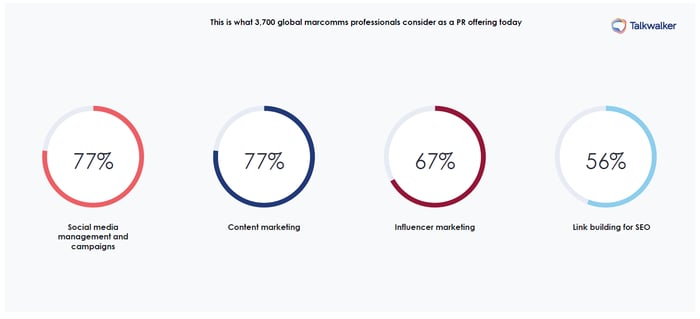
2020 Global State of PR report.
Media - owned vs paid vs earned
Public relations is divided into three main areas - owned, paid, earned. While working towards the same end result - boosting brand reputation - they take different routes.
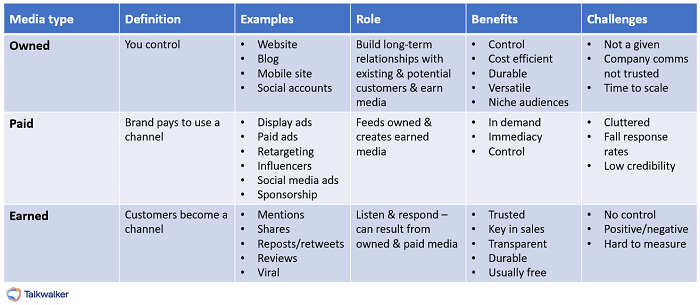
Owned, paid, earned media offer several options for publishing.
Your PR strategy needs to include all three types of media, because each will engage with your audience and increase trust in different and essential ways. They support separate parts of your sales funnel and without one, you’ll potentially jeopardize your marketing strategy.
Don’t forget… you may have written a cracking blog post, but if you don’t promote it - outreach - you’ll have wasted your time. It won’t be seen by the wider audience.
Check out my Essential Guide | Paid vs earned vs owned media, for more details on the differences between each type of media.
Owned media
Owned media is all the content that your company manages. Because you have total control, it’s the easiest media to handle, and the most important. When people mention your brand in content, on social media, in the press, they’ll almost definitely link to your owned media. Keep it looking good.
Owned media includes your…
- Website
- Blog posts
- Social media content
- RSS feeds
- Apps
- Stores - off and online
- Brochures - hard, soft
- Press releases
- Direct email campaigns
- LinkedIn posts, Facebook updates, LinkedIn articles, LinkedIn company profile
- Email newsletter - to contact lists you own
- Whitepapers, eBooks, case studies, reports
Paid media
Clue’s in the title.
Media that you’ve paid for, to promote your content. To increase its visibility. Considering that most social media channels are reducing organic reach for business accounts, paid media is the most effective way to ensure you get eyeballs on your content.
Paid media includes...
- Pay-per-click (PPC)
- Paid ads
- Retargeting
- Paid search
- Paid influencers
- Paid content promotion
- Social media ads
- Sponsored events
Earned media
Earned media is used to increase conversation about your brand. Like word of mouth, it’s a sure-fire way to improve your brand’s reputation.
It does involve hard work. You have to earn user-generated content. But when you get this social proof? Wow!
Earned media includes…
- Mentions
- Shares
- Customer reviews
- Reposts
- Recommendations
- High page ranking in SERPs
Check out my Customer review data post, for more details about how to get the most out of user-generated content.
Public relations vs marketing
Similar games. Different goals.
Your PR strategy will boost your marketing plan by increasing trust in your brand. But come a crisis - sorry, inevitable - your marketing plan won’t double up as a PR strategy.
A PR strategy boosts brand reputation
Public relations may not impact sales, but does promote your brand through events, sponsorships, press releases, etc.
A marketing plan drives sales
Marketing campaigns drive revenue and increase profits
The route consumers? They engage with your brand via one of your PR efforts. They convert and become a customer, due to your marketing plan.
What is a PR strategy?
A PR strategy is an agile roadmap. Flexible enough so that you can adapt it to new data, new opportunities, new markets, new competitors…
It’s a roadmap that takes you from your current situation to your end goal. It could be short-term or long-term. A single goal, such as positive media about your latest product release. Or, the long-term aim of meeting your business goals.
PR strategy tactics
“How does the public view your brand?”
Don’t fall into the trap of thinking that your PR strategy is merely how your brand is portrayed in the media. It includes communication inside your organization, as well as outside. The events you hold and attend. How you manage a PR crisis. Your involvement in your community. Your market.
PR tactics should include…
- Business and consumer communications
- Events
- Community relations
- Influencer marketing
- Crisis management
- Internal PR
- Media relations
- Social media
Business and consumer communications
Your corporate communication strategy is an integral part of your PR strategy. Whether internal or external, it’s your brand’s voice, and has to be consistent. You’ll be sharing vital comms - internal email to your team, press releases about new products, company news, and more.
Implement an email strategy. It’s estimated that for every $ spent on an email strategy, there’s an ROI of $30. 80% of marketers believe that email drives customer acquisition and retention. Even with social media, 72% of consumers prefer email as a means of communication.
Email strategy tactics include…
- Personalize your email to connect with recipients
- Include a clear CTA to encourage recipients to download, subscribe, follow, share…
- Write a catchy subject line that they can’t ignore
Find and keep the right voice, and you’ll strengthen your brand’s position in your market and industry.
Events
Business events are essential marketing tools and provide crucial sales opportunities. Events you host and those you attend. You get to meet up with prospects and promote your product, in person. You can catch-up with customers to strengthen relationships and gently upsell.
Get your C-level team involved with speaking at events to demonstrate thought leadership and increase brand awareness and trust.
Community relations
It’s important that your brand has a human face. A genuine human face. Forget about marketing and making money for a moment.
Bear with me...
Building positive relationships with your community - donations, education, charities, public health, environment, discounts - will reinforce customer loyalty.
Mind, it has to be honest community relations. Don’t be thinking of making a quick buck by making your brand look charitable. Consumers aren’t that dumb.
Influencer marketing
Influencer marketing has soared to new heights, with social media acting as the rocket fuel. The right influencer will help you reach new audiences and expose consumers to your brand in a way that leaves traditional marketing standing.
Influencer marketing drives 11 x more ROI than old school marketing. Consumers have lost faith in the hard-sell approach from marketers. We look to individuals for recommendations - peers, friends, colleagues, review sites, influencers.
Build a long-term influencer marketing strategy. Work on creating relationships with key influencers in your industry. Find influencers that will be loyal to your brand and understand your goals. This Influencer Marketing Guide will explain how to find the best influencers. How to start your influencer campaign. How to brief them. And, how to measure your results.
Crisis management
Every brand suffers a crisis at some point. Large and destructive, or small and irksome.
I know. I’m repeating myself. It's important.
If it has the potential to jeopardize your business and damage your brand’s reputation, you need public relations to manage it. Quickly, consistently, and strategically.
I’ve written a PR Crisis Management Guide. Rather than replicate, I’d strongly suggest you take a look. It explains best practices.
You may not be able to prevent a crisis, but you can be prepared.
GET YOUR FREE PR CRISIS MANAGEMENT EBOOK
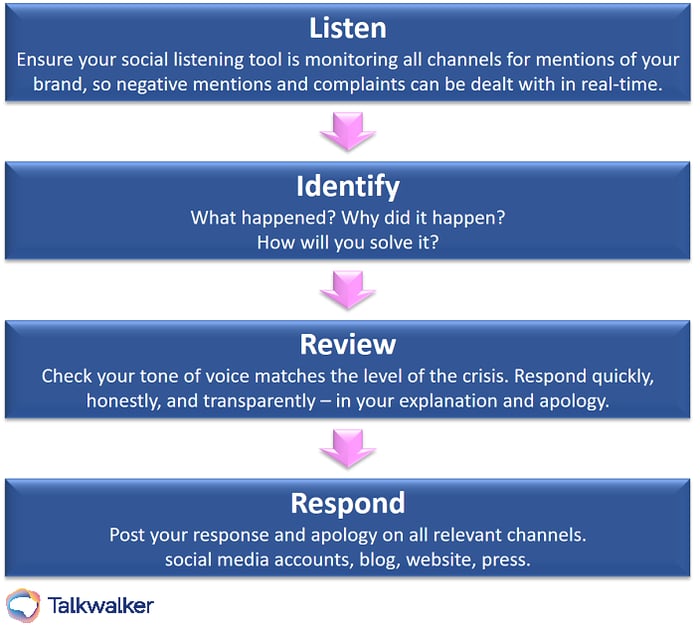
During a PR crisis - listen, identify, review, respond.
Internal PR
This boils down to cultivating a positive perception of your business, internally. Among your teams. I’m talking benefits - lunch vouchers, team events, newsletters, free training, free fruit. Get the idea?
Maintaining healthy employee relations keeps your team motivated, diligent, and loyal. You’ll also end up with dedicated brand advocates, willing to promote a brand they’re proud of and happy to work for. This is honest marketing that will bring in new customers and encourage new talent to your team.
Be transparent. Be respectful. Be honest.
Media relations
Always wise to be on good terms with journalists and the press.
Maintaining positive relationships with journalists and news outlets is essential if you’re looking to gain exposure for your brand.
Social media
Social media can be earned and paid media. It’s a vital marketing and PR tool that can help increase your number of followers. Be a platform for promoting your content. Convert prospects into customers. And, be an early warning sign of an oncoming crisis.
Your social channels will speak to consumers, so your social media strategy must be consistent in voice and brand identity, positive, honest, and… human.
If you need some guidance, take a look at my 23 social media tips.
How to create a PR strategy
- Review last year’s PR activity
- Define goals and objectives
- Identify target audiences
- Macro vs micro environment
- Create key messages
- Create content
- Choose PR tools
- Let’s talk PR tactics
To create your strategic PR plan, start with due diligence. Find what went wrong in the past. How did you, will you, fix them? Do you see any roadblocks that cause concern for future efforts?
Research is vital so that you can identify your existing opportunities and understand where and when to create new ones.
You’ll also determine who you’re trying to talk to. What they want from your brand. And, the best way to engage with them.
- First… research
- Second… create your PR strategy
Review last year’s PR activity
To move forward, you have to look back.
Wait… it does make sense.
Look at your public relations efforts for the past year. What did your competitors do? What was happening in your industry? Ask these questions, and…
- What media attention did you receive?
- How did it impact your business
- Was it positive or negative media attention?
- Did you get positive write-ups from any journos/bloggers/vloggers/review sites/social media?
- Did you get negative write-ups from any journos/bloggers/vloggers/review sites/social media?
A sentiment analysis tool will help you find all positive/negative/neutral brand mentions - How influential were the people sharing - nano, micro, macro? Followers? Engagement?
- How are you ranking and being portrayed on search engines - overall and past year?
For your website - check traffic, time on site, bounce rate
For blog posts - check SERPs, conversion rate
Talkwalker sentiment analysis results. Comparison between three major soft drink brands.
When you’ve answered these questions, start again. Ask the same about your competitors. To help you with this, I’m sharing my Competitor Analysis Guide. It explains how to do an in-depth study of your industry and its members - their strengths and weaknesses.
Analyze what you did. What your competitors did. Then - and only then - change, improve, build.
Define PR goals and objectives
Past performance explored. Competitors’ results analyzed. Now it’s time to decide what you want to accomplish. Your PR action plan.
Recognizing the results you want will support the numerous steps involved in creating your PR strategy. Your goals and objectives will help you determine the audiences you need to target. The messages you’ll need to craft. The tactics that’ll score your goals.
Your goals and objectives - if you know me, you know what I’m going to say - need to be SMART
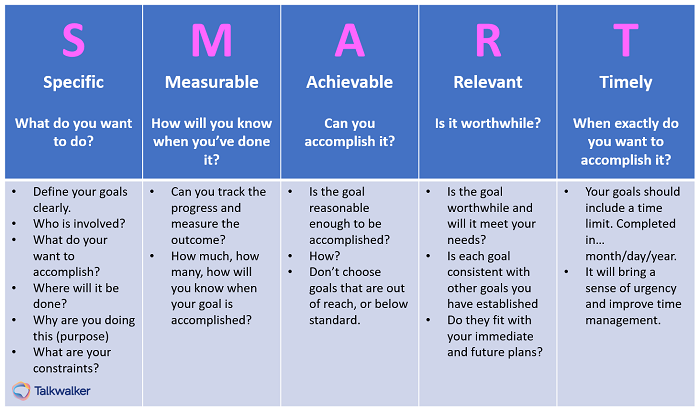
They must tie into your business goal. They must be measurable. You’re looking to increase your conversion rate. Great. By how much? Within what time period? If they can’t be measured. You won’t be able to prove that they’ve been met.
While your PR goals will be general and hard to measure, they must be achievable. Your PR objectives, on the other hand, have to be measurable, timely, and results oriented.
PR goals include…
- Increasing demand of your goods
- Improving your brand’s reputation
- Increasing brand awareness
The skill is, combining vague goals and discernable objectives. Here’s an example of a PR strategy goal and objective…
Goal = Brand reputation - fictional brand, Food On Your Plate, is a restaurant with a dwindling customer base. Its goal is to improve and promote its reputation, to encourage new visitors.
Objective = Create new USPs - pizza night, happy hour, invites customers to submit recipe suggestions - encourage customers to post positive reviews.
Identify target audiences
First up, clarify who you're talking about. Your target audience can be businesses or communities, individuals or groups.
Your goal will be to build strong, positive relationships with your key audience. That could include...
- Existing clients
- Prospects
- Partners
- Stakeholders
- Investors
- Government regulators
- Employees
- Media
Consider the goals you’ve chosen, and decide on the most appropriate audience. Which group will help you best accomplish your goals? Tailor your messages accordingly.
Creating your buyer persona - ideal customer - works for marketing and PR. Download my buyer persona template and complete.
Perform PEST analysis
PEST analysis - similar to crisis management - identifies changes in macro and micro environments - external factors - that could affect your business.
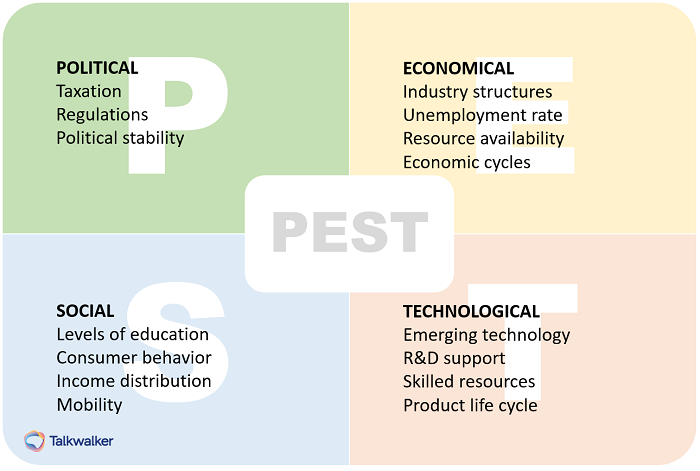
An example would be a press release alerting the public to a data breach of banking customers’ personal information. This would be considered a major crisis and the bank’s PR strategy would need to adapt.
Macro vs micro environment
These are big and uncontrollable factors. They can influence your decisions. They can affect your business’ performance. Your strategies may need to be updated.
Macro - economic factors, demographics, legal, politics, socio-cultural changes, societal trends, technological advances...
Micro - this environment is in direct contact with your business. It can immediately change your business routines.
Factors include…
- Customers
- Competitors
- Suppliers
- Distribution channels
- Employees
- Stakeholders
- Media
Create key messages
Your messages have several goals…
- Educate and inform your audience
- Change people’s perception of your brand
- Persuade consumers to take an action
Keep your messages concise and to the point. Write tailored messages for each of your objectives. Write key messages that’ll resonate with your target audiences.
To create your messages, ask yourself these questions…
- What do I want consumers to know about my brand and products?
- What’s my business’ mission?
- Why should consumers choose my brand over those of my competitors?
Create content
Content marketing plays a key part in your PR strategy. Because public relations is all about protecting and promoting your brand’s reputation, your content can work in several ways.
For instance, if you want your brand to be recognized as a thought leader, your content should be educational. Proving your expertise to your audience and within your industry. Share key insights, social data, trends…
If consumers recognize your expertise, your brand’s reputation will strengthen. They’ll share your insights. They’ll trust you.
Awesome word-of-mouth marketing.
A perfect example of this is the Moz Whiteboard Friday campaign. SEO and marketing experts share educational videos. The company has found a unique way of engaging with its audience.
From off-topic backlinks to cookie-cutter anchor text, there are more than a few clues hidden in your backlink profile that something spammy is going on.
7 Red Flags to Watch Out For when Auditing Your Link Profile #WhiteboardFridayhttps://t.co/eV7oSs3Vdj via @Kammie_Jenkins
— Moz (@Moz) March 1, 2019
According to the Content Marketing Institute, 80% of B2B marketers have a content strategy, but only one third have it documented. Plan your content strategy now. Check out my Content Strategy Guide. It’s gonna show you how.
Choose PR tools
Created your content?
How are you going to get eyeballs on it?
You’ll need to monitor your online brand mentions. Find the best journalists. Outreach…
It’s a big job, but someone’s gotta do it.
I won’t go into too much depth in this post. I think you’ve more than enough to take on. But, when you’re ready, take a look at The Best PR Tools For Public Relations Professionals. I trawled through a heap of PR tools and pulled out the best. You’ll find 35 expert recommended tools for…
- Finding journos and influencers
- Identifying contact details
- Knowing who’s opened your email
- Spotting trends
- Finding media opportunities
- Writing content
- SEO analysis
- Designing images
- Management and collaboration
- Distributing your press releases
- Outreaching your content
Let’s talk PR tactics
Messaging written. Tools sharpened.
What tactics will you use?
Allow one of our faves to help… the PESO method.
“The best part about the PESO model is that it’s fluid. So if owned media doesn’t work for you, you don’t have to use it for the model to be successful… you have four media types that, when used together, create authority, build awareness, and generate qualified leads.”
Gini Dietrich | Creator of the PESO model | Spin Sucks
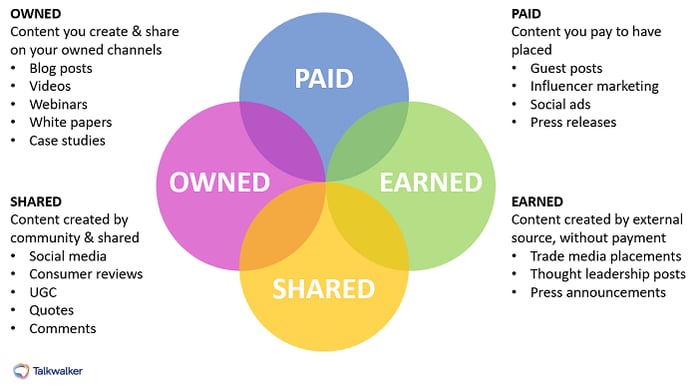
Dietrich’s PESO model (image adapted from Spin Sucks).
It’s the only way a business can earn the attention of its intended audience. It includes paid, earned, shared, and owned media. Sharing refers to the sharing or/commenting on your messages by communities on social channels. Remember… I talked about the others earlier?
Check out my Essential Guide | Paid vs earned vs owned media, for more details on the differences between each type of media.
How does it work?
Use a combo of all four media types. Yep, that simple.
- You’ve created your content, so you can tick owned media.
- Distribute your content with shared media. I’m talking about social media. Tailored for each social channel. What works on Twitter, won’t work on LinkedIn. You can check best practices with this Social Media Messaging Checklist. It’ll explain which tone to use. Image sizes. Posting schedule, and more.
- Amplify with paid media. This would include sponsored content. Paid guest posts. Social ads. Sponsored tweets. Test. Test. Test. Start off slow and see what works, so you don’t waste money.
- Build relationships for earned media. Encourage bloggers, vloggers, journalists, influencers to share your content with their followers.
Thanks Gini.
PR measurement
Remember the goals you set earlier? Now’s the time to measure results. Did you score a hit, or not?
You’ll need to define what you’re going to measure, how often. Daily, weekly, monthly, quarterly? Each media type has different KPIs. For example…
Social media…
- Engagement
- Reach
- Referrals
- Follower growth
- Conversions
Your website...
- Traffic
- Bounce rate
- Page views
- Time on site
- Referrals
- Conversion rate
Email...
- Click-through rate
- Open rate
- Unsubscribes
The Barcelona Principles
In 2010, a team of PR experts in Barcelona met to talk about PR measurement and the demise of AVEs. The Barcelona Principles were born. A universal standard of measurement, the principles recognize the need for outcome, as opposed to output based PR measurement. Also, social media was included as a new and relevant means of communication.
There are seven guidelines that you should implement. I’m going to show you the original 2010 version, and the updated one from 2015.
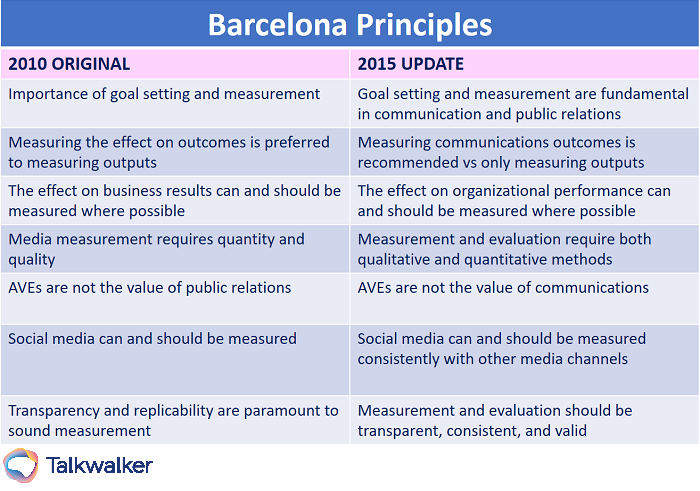
Check here for more information about The Barcelona Principles.
It’s a simple process…
Start with your goals. Check results - did you meet your goals? When your PR goals align with your business goals, it’ll be easier to demonstrate the success and value of your PR strategy. You’ll learn what’s working and what isn’t. Meaning you can then improve. Improve. Improve.
I wrote a bumper PR Measurement Guide, that digs deep into the value of measuring your PR efforts. How to plan, PR tools, and a whole lot more. Take a look!
PR metrics to measure
Too busy to read the guide? Meh!
Here are the most important metrics - from traditional to digital - that’ll demonstrate the impact of PR on your brand...
- Backlinks to your website
- Mentions of your brand
- Conversions
- Domain authority
- Sentiment analysis
- Website traffic
- Social media engagement
Backlinks to your website
How many backlinks and where did they come from? Websites that have mentioned your brand and included a link to your site, providing a route for readers. The higher the domain authority of the website, the more valuable the link.
You’ll win new traffic and an improvement in your page ranking.
Mentions of your brand
Clue’s in the name…
When a consumer talks about your brand, this increases awareness of your brand. They can occur in press releases, newspapers, social media, blog posts, guest posts, review sites, forums, and more.
Remember those PR Tools I found for you? They’ll come into their own for this consumer insights metric.
Take a look at my Consumer insights guide, to learn how they will help you understand and interpret customer data, behavior, sentiment, wants, needs, attitude, and feedback, to power data-driven business decisions.
Conversions
You’ll need Google Analytics for this, so you can investigate the conversion path a customer took. Their route to purchase.
Alternatively, you could take the retro route, and when you win a new customer… ask how they heard about your brand.
Domain authority
Domain authority (DA) is an important SEO ranking factor. It demonstrates the power a domain name has. It’s strength. Based on the age of your site, popularity, size. Factors include links to - from well-ranked sites - and from your website. It ranks 1 to 100, with 100 being the highest.
You can’t flick a switch and increase your domain authority, but use PR to attract backlinks from high authority websites.
Domain authority example - .GOV domains tend to have a high DA because they’re considered credible sites.
What’s the DA of your website, compared to that of your competitor?
Sentiment analysis
It’s all very well collecting a heap of brand mentions, but if you don’t know the sentiment behind them, you’re left in the dark.
Performing sentiment analysis will separate the positive from the negative. It’s important to be aware of any negative comments about your brand, so you quickly address the situation before it spins out of control.
You guessed it… I’ve got a set of sentiment analysis tools for you to use. Take a look!
Website traffic
Google Analytics again…
If your website traffic is strong, it means your PR strategy is working. You’re reaching consumers. End of…
When you’re running your PR campaigns, track your site traffic with Google Analytics. Find visitors’ referral sources - their route to your website - and employ the same strategy for future campaigns.
Social media engagement
Monitor brand awareness and engagement with your audience on social media. Use a social media listening tool to track and analyze social media metrics and you’ll identify where improvement is needed. You’ll get to know consumers.

Talkwalker Analytics - social media metrics tool to track and visualize social data.
Yep, there’s a guide. 20 Social Media Metrics That Matter digs deep into social media analytics used to measure the impact of your presence on social media, and the revenue your social strategy is bringing to your business. You’ll learn…
- What consumers like and dislike
- What they think of your brand
- How engaged they are - what they’re sharing, liking...
- Their global locations
- The languages they’re speaking
- How many website visits you’re earning
- Their purchasing habits
- Your conversion rate
To investigate consumers further, Conduct a Consumer Behavior Analysis. With it, you’ll understand what influences consumers’ purchasing decisions - off or online - and be able to target your marketing and PR strategies.
Takeaway - Free PR crisis eBook
PR is good for your business.
You can’t buy good PR. You have to work for it. A value can’t be put on the trust you’ll earn. Your target market will learn about your brand without having hard-sell marketing campaigns rammed down their throats. Which, considering today’s consumers, means increased brand awareness and reputation. Your PR strategy will have made consumers fall in love with your brand.
Can’t be bad.
Be prepared. “It won’t happen” is shortsighted, naive, pure fantasy.
A crisis need not be a disaster for your brand. You can even win new customers, impressed with your response, and it can help drive necessary change and improvements to your working methods.
Remember: get ready, respond, reflect.

How to create your PR strategy
Looking to get eyeballs on your brand? To promote your products or services to a new audience? Public relations defines how a company communicates with people - customers, prospects, partners, journalists, and more. Regardless the size of your business, or which industry you’re in, you need a PR strategy. Let’s publicize...
CTA - PR survey?/crisis template
Today’s consumers are looking to trust the brands they use. They want honest messaging. Personalization. So, lose the hard-sell brand-brand speak.
IMAGE
Table of contents
-
Why your brand needs a PR strategy
-
Definition of public relations
-
Media - owned vs paid vs earned
-
Public relations vs marketing
-
What is a PR strategy?
-
PR strategy tactics
-
How to create a PR strategy
-
PR measurement
-
Takeaway - PR survey
Why your brand needs a PR strategy
I wrote earlier that every brand needs a PR strategy. You could ignore me, but your brand will struggle to be heard in your industry and market. With a PR strategy, consumers won’t be able to ignore you. You’ll capture their eyeballs.
Nice image in my head right now.
From increasing brand awareness to lead generation. Crisis management to investment opportunities. A comprehensive public relations strategy can accomplish a variety of goals, including...
-
Strengthen and increase brand awareness
Generate consumer interest with your PR strategy and you’ll support and reinforce your marketing campaigns. Directing consumers through your sales funnel to a purchase. -
Increase investment opportunities
Get your timing right, and media placements will attract investors. You’ll increase your brand’s credibility as a safe bet. You’ll have venture capitalists beating down your door, wanting to give you cash. -
Increase lead generation
Promoting your brand across a variety of media - press, social media, blogs, TV, forums, reviews, news sites - will increase its visibility. You’ll be presenting your products to way more eyeballs. Prospects’ eyeballs. -
Recruit industry talent
Looking for new team members? A strategic PR plan will demonstrate your business as a thought leader. You’ll be flooded with CVs from talent desperate to work with you. Flip the coin, and you’ll boost team spirit, reducing churn of current employees. -
Create trust with effective branding
Your PR strategy will bring clarity to your marketing campaigns and your brand’s identity. Concentrate on your business’ key characteristics and USPs. Tell your story and you’ll give your business a human face. Get your messaging right, and trust will increase. -
Manage and recover from a crisis
Happens to the best of us, but with a strong PR strategy in place you’ll be ready for the worst. Develop a PR crisis management plan and you’ll be ready to protect your public image.
Definition of public relations
Using numerous and various media channels to promote your business. To promote a positive public awareness of your brand. Additionally, during a crisis, PR is the most effective way to manage your communication.
Like branding, public relations manages the dissemination of your message. Unlike branding, PR is about communication and your reputation. Branding covers elements that include your logo, website, and other marketing assets.
To manage your PR, you’ll use various media channels - owned, paid, earned
PR Survey link
Media - owned vs paid vs earned
Public relations is divided into three main areas - owned, paid, earned. While working towards the same end result - boosting brand reputation - they take different routes.

Owned, paid, earned media offer several options for publishing.
Your PR strategy needs to include all three types of media, because they will engage with your audience and increase trust in different and essential ways. They support separate parts of your sales funnel and without one, you’ll potentially jeopardize your marketing strategy.
Don’t forget… you may have written a cracking blog post, but if you don’t promote it - outreach - you’ll have wasted your time. It won’t be seen by the wider audience.
Owned media
Owned media is all the content that your company manages. Because you have total control, it’s the easiest media to handle, and the most important. When people mention your brand in content, on social media, in the press, they’ll almost definitely link to your owned media. Keep it looking good.
Owned media includes your…
-
Website
-
Blog
-
Newsletter
-
Social media channels
Paid media
Clue’s in the title.
Media that you’ve paid for, to promote your content. To increase its visibility. Considering that most social media channels are reducing organic reach for business accounts, paid media is the most effective way to ensure you get eyeballs on your content.
Paid media includes...
-
Pay-per-click (PPC)
-
Paid ads
-
Retargeting
-
Paid influencers
-
Paid content promotion
-
Social media ads
-
Sponsored events
Earned media
Earned media is used to increase conversation about your brand. Like word of mouth, it’s a sure-fire way to improve your brand’s reputation.
It does involve hard work. You have to earn the chat. But when you get it? Wow!
Earned media includes…
-
Mentions
-
Shares
-
Reviews
-
Reposts
-
Recommendations
-
High page ranking in SERPs
Public relations vs marketing
Similar games. Different goals.
Your PR strategy will boost your marketing plan by increasing trust in your brand. But come a crisis - sorry, inevitable - your marketing plan won’t double up as a PR strategy.
-
A PR strategy boosts brand reputation
Public relations may not impact sales, but does promote your brand through events, sponsorships, press releases, etc. -
A marketing plan drives sales
Marketing campaigns drive revenue and increase profits
The route consumers? They engage with your brand via one of your PR efforts. They convert and become a customer, due to your marketing plan.
What is a PR strategy?
A PR strategy is an agile roadmap. Flexible enough so that you can adapt it to new data, new opportunities, new markets…
It’s a roadmap that takes you from your current situation to your end goal. It could be short-term or long-term. A single goal, such as positive media about your latest product release. Or, the long-term aim of meeting your business goals.
PR strategy tactics
“How does the public view your brand?”
Don’t fall into the trap of thinking that your PR strategy is merely how your brand is portrayed in the media. It includes communication inside your organization, as well as outside. The events you hold and attend. How you manage a PR crisis. Your involvement in your community. Your market.
PR tactics should include…
-
Business and consumer communications
-
Events
-
Community relations
-
Influencer marketing
-
Crisis management
-
Internal PR
-
Media relations
-
Social media
Business and consumer communications
Your corporate communication strategy is an integral part of your PR strategy. Whether internal or external, it’s your brand’s voice, and has to be consistent. You’ll be sharing vital comms - internal email to your team, press releases about new products, company news, and more.
Implement an email strategy. It’s estimated that for every $ spent on an email strategy, there’s an ROI of $30. 80% of marketers believe that email drives customer acquisition and retention. Even with social media, 72% of consumers prefer email as a means of communication.
Email strategy tactics include…
-
Personalize your email to connect with recipients
-
Include a clear CTA to encourage recipients to download, subscribe, follow, share…
-
Write a catchy subject line that they can’t ignore
Find and keep the right voice, and you’ll strengthen your brand’s position in your market and industry.
Events
Business events are essential marketing tools and provide crucial sales opportunities. Events you host and those you attend. You get to meet up with prospects and promote your product, in person. You can catch-up with customers to strengthen relationships and gentle upselling.
Get your C-level team involved with speaking at events to demonstrate thought leadership and increase brand awareness and trust.
Community relations
It’s important that your brand has a human face. A genuine human face. Forget about marketing and making money for a moment.
Bear with me...
Building positive relationships with your community - donations, education, charities, public health, environment, discounts - will reinforce customer loyalty.
Mind, it has to be honest community relations. Don’t be thinking of making a quick buck by making your brand look charitable. Consumers aren’t that dumb.
Influencer Marketing
Influencer marketing has soared to new heights, with social media acting as the rocket fuel. The right influencer will help you reach new audiences and expose consumers to your brand in a way that leaves traditional marketing standing.
Influencer marketing drives 11 x more ROI than old school marketing. Consumers have lost faith in the hard-sell approach from marketers. We look to individuals for recommendations - peers, friends, colleagues, review sites, influencers.
Build a long-term influencer marketing strategy. Work on creating relationships with key influencers in your industry. Find influencers that will be loyal to your brand and understand your goals. This Influencer Marketing Guide will explain how to find the best influencers. How to start your influencer campaign. How to brief them. And, how to measure your results.
Crisis management
Every brand suffers a crisis at some point. Large and destructive, or small and irksome.
I know. I’m repeating myself. Get used to it.
If it has the potential to jeopardize your business and damage your brand’s reputation, you need public relations to manage it. Quickly, consistently, and strategically.
I’ve written a PR Crisis Management Guide. Rather than replicate, I’d strongly suggest you take a look. It explains best practices. How to prepare, manage, and report.
You may not be able to prevent a crisis, but you can be prepared.
Crisis templates
caption….
Internal PR
This boils down to cultivating a positive perception of your business, internally. Among your teams. I’m talking benefits, lunch vouchers, team events, newsletters, free training, free fruit. Get the idea?
Maintaining healthy employee relations keeps your team motivated, diligent, and loyal. You’ll also end up with dedicated brand advocates, willing to promote a brand they’re proud of and happy to work for. This is honest marketing that will bring in new customers and encourage new talent to your team.
Be transparent. Be respectful. Be honest.
Media relations
Always wise to be on good terms with journalists and the press.
Maintaining positive relationships with journalists and news outlets is essential if you’re looking to gain exposure for your brand.
Social media
Social media can be earned and paid media. It’s a vital marketing and PR tool that can help increase your number of followers. Be a platform for promoting your content. Convert prospects into customers. And, be an early warning sign of an oncoming crisis.
Your social channels will speak to consumers, so your social media strategy must be consistent in voice and brand identity, positive, honest, and… human.
How to create a PR strategy
-
Review last year’s PR activity
-
Define goals and objectives
-
Identify target audiences
-
Macro vs micro environment
-
Create key messages
-
Create content
-
Choose PR tools
-
Let’s talk PR tactics
To create your strategic PR plan, start with due diligence. Find what went wrong in the past. How did you, will you, fix them? Do you see any roadblocks that cause concern for future efforts?
Research is vital so that you can identify your existing opportunities and understand where and when to create new ones.
You’ll also determine who you’re trying to talk to. What they want from your brand. And, the best way to engage with them.
-
First… research
-
Second… create your PR strategy
Review last year’s PR activity
To move forward, you have to look back.
Wait… it does make sense.
Look at your public relations efforts for the past year. What did your competitors do? What was happening in your industry? Ask these questions, and…
-
What media attention did you receive?
-
How did it impact your business?
-
Was it positive or negative media attention?
-
Did you get positive write-ups from any journos/bloggers/vloggers/review sites/social media?
-
Did you get negative write-ups from any journos/bloggers/vloggers/review sites/social media?
A sentiment analysis tool will help you find all positive/negative/neutral brand mentions -
How influential were the people sharing - nano, micro, macro? Followers? Engagement?
-
How are you ranking and being portrayed on search engines - overall and past year?
For your website - check traffic, time on site, bounce rate
For blog posts - check SERPs, conversion rate
When you’ve answered these questions, start again. Ask the same about your competitors. To help you with this, I’m sharing my Competitor Analysis Guide. It explains how to do an in-depth study of your industry and its members - their strengths and weaknesses.
Analyze what you did. What your competitors did. Then - and only then - change, improve, build.
Define PR goals and objectives
Past performance explored. Competitors’ results analyzed. Now it’s time to decide what you want to accomplish. Your PR action plan.
Recognizing the results you want will support the numerous steps involved in creating your PR strategy. Your goals and objectives will help you determine the audiences you need to target. The messages you’ll need to craft. The tactics that’ll score your goals.
Your goals and objectives - if you know me, you know what I’m going to say - need to be SMART

PR strategy goals & objectives - Specific. Measurable. Achievable. Relevant. Time-bound.
They must tie into your business goal. They must be measurable. You’re looking to increase your conversion rate. Great. By how much? Within what time period? If they can’t be measured. You won’t be able to prove that they’ve been met.
While your PR goals will be general and hard to measure, they must be achievable. Your PR objectives, on the other hand, have to be measurable, timely, and results oriented.
PR goals include…
-
Increasing demand of your goods
-
Improving your brand’s reputation
-
Increasing brand awareness
The skill is, combining vague goals and discernable objectives. Here’s an example of a PR strategy goal and objective…
Goal = Brand reputation - fictional brand, Food On Your Plate, is a restaurant with a dwindling customer base. Its goal is to improve and promote its reputation, to encourage new visitors.
Objective = Create new USPs - pizza night, happy hour, invites customers to submit recipe suggestions - encourage customers to post positive reviews.
Identify target audiences
First up, clarify who you're talking about. Your target audience can be businesses or communities, individuals or groups.
Your goal will be to build strong, positive relationships with your key audience. That could include...
-
Existing clients
-
Prospects
-
Partners
-
Stakeholders
-
Investors
-
Government regulators
-
Employees
-
Media
Consider the goals you’ve chosen, and decide on the most appropriate audience. Which group will help you best accomplish your goals? Tailor your messages accordingly.
Creating your buyer persona - ideal customer - works for marketing and PR. Download my buyer persona template and complete.
Perform PEST analysis
PEST analysis - similar to crisis management - identifies changes in macro and micro environments - external factors - that could affect your business.
PEST image
PEST for external macro and micro environments.
An example would be a press release alerting the public to a data breach of banking customers’ personal information. This would be considered a major crisis and the bank’s PR strategy would need to adapt.
Macro vs micro environment
These are big and uncontrollable factors. They can influence your decisions. They can affect your business’ performance. Your strategies may need to be updated.
Macro - economic factors, demographics, legal, politics, socio-cultural changes, societal trends, technological advances...
Micro - this environment is in direct contact with your business. It can immediately change your business routines.
Factors include…
-
Customers
-
Competitors
-
Suppliers
-
Distribution channels
-
Employees
-
Stakeholders
-
Media
PEST model image.
Create key messages
Your messages have several goals…
-
Educate and inform your audience
-
Change people’s perception of your brand
-
Persuade consumers to take an action
Keep your messages concise and to the point. Write tailored messages for each of your objectives. Write key messages that’ll resonate with your target audiences.
To create your messages, ask yourself these questions…
-
What do I want consumers to know about my brand and products?
-
What’s my business’ mission?
-
Why should consumers choose my brand over those of my competitors?
Create content
Content marketing plays a key part in your PR strategy. Because public relations is all about protecting and promoting your brand’s reputation, your content can work in several ways.
For instance, if you want your brand to be recognized as a thought leader, your content should be educational. Proving your expertise to your audience and within your industry. Share key insights, social data, trends…
If consumers recognize your expertise, your brand’s reputation will strengthen. They’ll share your insights. They’ll trust you.
Awesome word-of-mouth marketing.
A perfect example of this is the Moz Whiteboard Friday campaign. SEO and marketing experts share educational videos. The company has found a unique way of engaging with its audience.
IMAGE
caption
According to the Content Marketing Institute, 80% of B2B marketers have a content strategy, but only one third have it documented. Plan your content strategy now. Check out my Content Strategy Guide. It’s gonna show you how.
Choose PR tools
Created your content?
How are you going to get eyeballs on it?
You’ll need to monitor your online brand mentions. Find the best journalists. Outreach…
It’s a big job, but someone’s gotta do it.
I won’t go into too much depth in this post. I think you’ve more than enough to take on. But, when you’re ready, take a look at The Best PR Tools For Public Relations Professionals. I trawled through a heap of PR tools and pulled out the best. You’ll find 35 expert recommended tools for…
-
Finding journos and influencers
-
Identifying contact details
-
Knowing who’s opened your email
-
Spotting trends
-
Finding media opportunities
-
Writing content
-
SEO analysis
-
Designing images
-
Management and collaboration
-
Distributing your press releases
-
Outreaching your content
Let’s talk PR tactics
Messaging written. Tools sharpened.
What tactics will you use?
Allow one of our faves to help… the PESO method.
“The best part about the PESO model is that it’s fluid. So if owned media doesn’t work for you, you don’t have to use it for the model to be successful… you have four media types that, when used together, create authority, build awareness, and generate qualified leads.”
Gini Dietrich | Creator of the PESO model | Spin Sucks

Dietrich’s PESO model (image adapted from Spin Sucks).
It’s the only way a business can earn the attention of its intended audience. It includes paid, earned, shared, and owned media. Sharing refers to the sharing or/commenting on your messages by communities on social channels. Remember… I talked about the others earlier?
How does it work?
Use a combo of all four media types. Yep, that simple.
-
You’ve created your content, so you can tick owned media.
-
Distribute your content with shared media. I’m talking about social media. Tailored for each social channel. What works on Twitter, won’t work on LinkedIn. You can check best practices with this Social Media Messaging Checklist. It’ll explain which tone to use. Image sizes. Posting schedule, and more.
-
Amplify with paid media. This would include sponsored content. Paid guest posts. Social ads. Sponsored tweets. Test. Test. Test. Start off slow and see what works, so you don’t waste money.
-
Build relationships for earned media. Encourage bloggers, vloggers, journalists, influencers to share your content with their followers.
Thanks Gini.
PR measurement
Remember the goals you set earlier? Now’s the time to measure results. Did you score a hit, or not?
You’ll need to define what you’re going to measure, how often. Daily, weekly, monthly, quarterly? Each media type has different KPIs. For example…
Social media…
-
Engagement
-
Reach
-
Referrals
-
Follower growth
Your website...
-
Traffic
-
Bounce rate
-
Page views
-
Time on site
-
Referrals
-
Conversion rate
Email...
-
Click-through rate
-
Open rate
-
Unsubscribes
The Barcelona Principles
In 2010, a team of PR experts in Barcelona met to talk about PR measurement and the demise of AVEs. The Barcelona Principles were born. A universal standard of measurement, the principles recognize the need for outcome, as opposed to output based PR measurement. Also, social media was included as a new and relevant means of communication.
There are seven guidelines that you should implement. I’m going to show you the original 2010 version, and the updated one from 2015.

Check here for more information about The Barcelona Principles.
It’s a simple process…
Start with your goals. Check results - did you meet your goals? When your PR goals align with your business goals, it’ll be easier to demonstrate the success and value of your PR strategy. You’ll learn what’s working and what isn’t. Meaning you can then improve. Improve. Improve.
I wrote a bumper PR Measurement Guide, that digs deep into the value of measuring your PR efforts. How to plan, PR tools, and a whole lot more. Take a look!
PR metrics to measure
Too busy to read the guide? Meh!
Here are the most important metrics - from traditional to digital - that’ll demonstrate the impact of PR on your brand...
-
Backlinks to your website
-
Mentions of your brand
-
Conversions
-
Domain authority
-
Sentiment
-
Site traffic
-
Social media engagement
-
Social shares
Backlinks to your website
How many backlinks and where did they come from? Websites that have mentioned your brand and included a link to your site, providing a route for readers. The higher the domain authority of the website, the more valuable the link.
You’ll win new traffic and an improvement in your page ranking.
Mentions of your brand
Clue’s in the name…
When a person talks about your brand, this increases awareness of your brand. They can occur in press releases, newspapers, social media, blog posts, guest posts, review sites, forums, and more.
Remember those PR Tools I found for you? They’ll come into their own for this metric.
Conversions
You’ll need Google Analytics for this, so you can investigate the conversion path a customer took. Their route to purchase.
Alternatively, you could take the retro route, and when you win a new customer… ask how they heard about your brand.
Domain authority
Domain authority (DA) is an important SEO ranking factor. It demonstrates the power a domain name has. It’s strength. Based on the age of your site, popularity, size. Factors include links to - from well-ranked sites - and from your website. It ranks 1 to 100, with 100 being the highest.
You can’t flick a switch and increase your domain authority, but use PR to attract backlinks from high authority websites.
Domain authority example - .GOV domains tend to have a high DA because they’re considered credible sites.
What’s the DA of your website, compared to that of your competitor?
Sentiment analysis
It’s all very well collecting a heap of brand mentions, but if you don’t know the sentiment behind them, you’re left in the dark.
Performing sentiment analysis will separate the positive from the negative. It’s important to be aware of any negative comments about your brand, so you quickly address the situation before it spins out of control.
You guessed it… I’ve got a set of sentiment analysis tools for you to use. Take a look!
IMAGE
Talkwalker sentiment analysis...
Website traffic
Google Analytics again…
If your website traffic is strong, it means your PR strategy is working. You’re reaching consumers. End of…
When you’re running your PR campaigns, track your site traffic with Google Analytics. Find visitors’ referral sources - their route to your website - and employ the same strategy for future campaigns.
Social media engagement
Monitor brand awareness and engagement with your audience on social media. Track and analyze social media metrics and you’ll identify where improvement is needed. You’ll get to know consumers.
Yep, there’s a guide. 20 Social Media Metrics That Matter digs deep into social media analytics used to measure the impact of your presence on social media, and the revenue your social strategy is bringing to your business. You’ll learn…
-
What consumers like and dislike
-
What they think of your brand
-
How engaged they are - what they’re sharing, liking...
-
Their global locations
-
The languages they’re speaking
-
How many website visits you’re earning
-
Their purchasing habits
-
Your conversion rate
To investigate consumers further, Conduct a Consumer Behavior Analysis. With it, you’ll understand what influences consumers’ purchasing decisions - off or online - and be able to target your marketing and PR strategies.
Takeaway
PR is good for your business.
You can’t buy good PR. You have to work for it. A value can’t be put on the trust you’ll earn. Your target market will learn about your brand without having hard-sell marketing campaigns rammed down their throats. Which, considering today’s consumers, means increased brand awareness and reputation. Your PR strategy will have made consumers fall in love with your brand.
Can’t be bad.
CTA PR survey/crisis templates

